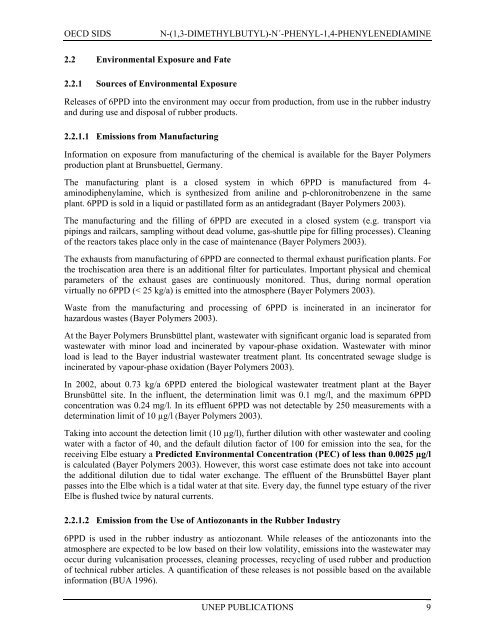N-(1,3-Dimethylbutyl)-N
N-(1,3-Dimethylbutyl)-N
N-(1,3-Dimethylbutyl)-N
Create successful ePaper yourself
Turn your PDF publications into a flip-book with our unique Google optimized e-Paper software.
OECD SIDS<br />
N-(1,3-DIMETHYLBUTYL)-N´-PHENYL-1,4-PHENYLENEDIAMINE<br />
2.2 Environmental Exposure and Fate<br />
2.2.1 Sources of Environmental Exposure<br />
Releases of 6PPD into the environment may occur from production, from use in the rubber industry<br />
and during use and disposal of rubber products.<br />
2.2.1.1 Emissions from Manufacturing<br />
Information on exposure from manufacturing of the chemical is available for the Bayer Polymers<br />
production plant at Brunsbuettel, Germany.<br />
The manufacturing plant is a closed system in which 6PPD is manufactured from 4-<br />
aminodiphenylamine, which is synthesized from aniline and p-chloronitrobenzene in the same<br />
plant. 6PPD is sold in a liquid or pastillated form as an antidegradant (Bayer Polymers 2003).<br />
The manufacturing and the filling of 6PPD are executed in a closed system (e.g. transport via<br />
pipings and railcars, sampling without dead volume, gas-shuttle pipe for filling processes). Cleaning<br />
of the reactors takes place only in the case of maintenance (Bayer Polymers 2003).<br />
The exhausts from manufacturing of 6PPD are connected to thermal exhaust purification plants. For<br />
the trochiscation area there is an additional filter for particulates. Important physical and chemical<br />
parameters of the exhaust gases are continuously monitored. Thus, during normal operation<br />
virtually no 6PPD (< 25 kg/a) is emitted into the atmosphere (Bayer Polymers 2003).<br />
Waste from the manufacturing and processing of 6PPD is incinerated in an incinerator for<br />
hazardous wastes (Bayer Polymers 2003).<br />
At the Bayer Polymers Brunsbüttel plant, wastewater with significant organic load is separated from<br />
wastewater with minor load and incinerated by vapour-phase oxidation. Wastewater with minor<br />
load is lead to the Bayer industrial wastewater treatment plant. Its concentrated sewage sludge is<br />
incinerated by vapour-phase oxidation (Bayer Polymers 2003).<br />
In 2002, about 0.73 kg/a 6PPD entered the biological wastewater treatment plant at the Bayer<br />
Brunsbüttel site. In the influent, the determination limit was 0.1 mg/l, and the maximum 6PPD<br />
concentration was 0.24 mg/l. In its effluent 6PPD was not detectable by 250 measurements with a<br />
determination limit of 10 µg/l (Bayer Polymers 2003).<br />
Taking into account the detection limit (10 µg/l), further dilution with other wastewater and cooling<br />
water with a factor of 40, and the default dilution factor of 100 for emission into the sea, for the<br />
receiving Elbe estuary a Predicted Environmental Concentration (PEC) of less than 0.0025 µg/l<br />
is calculated (Bayer Polymers 2003). However, this worst case estimate does not take into account<br />
the additional dilution due to tidal water exchange. The effluent of the Brunsbüttel Bayer plant<br />
passes into the Elbe which is a tidal water at that site. Every day, the funnel type estuary of the river<br />
Elbe is flushed twice by natural currents.<br />
2.2.1.2 Emission from the Use of Antiozonants in the Rubber Industry<br />
6PPD is used in the rubber industry as antiozonant. While releases of the antiozonants into the<br />
atmosphere are expected to be low based on their low volatility, emissions into the wastewater may<br />
occur during vulcanisation processes, cleaning processes, recycling of used rubber and production<br />
of technical rubber articles. A quantification of these releases is not possible based on the available<br />
information (BUA 1996).<br />
UNEP PUBLICATIONS 9
















